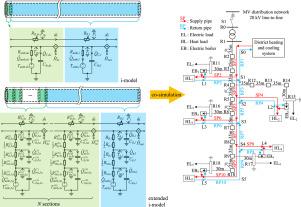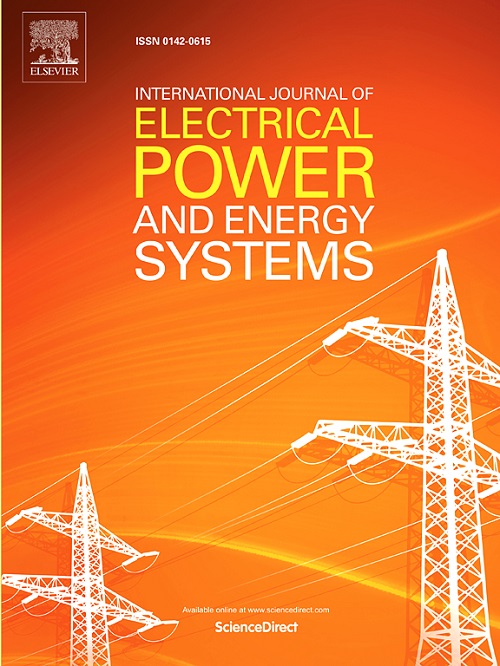Dynamic models of pipe using circuit equivalents for efficient co-simulation of electric and thermal transients in energy system
IF 5
2区 工程技术
Q1 ENGINEERING, ELECTRICAL & ELECTRONIC
International Journal of Electrical Power & Energy Systems
Pub Date : 2025-09-09
DOI:10.1016/j.ijepes.2025.111011
引用次数: 0
Abstract
As power-to-heat technologies are increasingly utilized to support the heating and cooling demand in the building and industry sectors, electric power systems will integrate more closely with heating and cooling systems. The interaction between different energy systems becomes important for system operators. It would be beneficial for grid operators to model heating and cooling systems in the simulation environments typically used for the analysis of electric systems. To facilitate such simulation, two novel models for pipes are proposed in this paper. Based on the analogy between thermal quantities and electric quantities, electric circuit equivalents are used to develop the models. In the proposed models, the hydraulic and thermal quantities of fluid in a pipe are represented by electrical quantities. By exploitating the “end-to-end” thermal relationship of a pipe, the first model comprises only two nodes for a pipe and is thus computationally efficient. Taking axial diffusion into account, the second model is extended from the first model to capture fast thermal transients. Both models have been validated against experimental measurement data for slow transients with an error less than 1%. The second model additionally provides highly accurate approximation to fast transients. The value of the models is explained and demonstrated through a case study thereafter. With the proposed pipe models, thermal dynamics in pipes can be efficiently simulated in circuit-oriented simulators. The proposed work extends the application scope of such simulators and improves the simulation efficiency. This facilitates the analysis of energy interactions between power systems with district heating and cooling systems.

利用电路等效的管道动力学模型,有效地联合模拟能源系统中的电和热瞬态
随着电力到热技术越来越多地用于支持建筑和工业部门的加热和冷却需求,电力系统将与加热和冷却系统更紧密地结合在一起。不同能源系统之间的相互作用对系统操作员来说变得很重要。对于电网运营商来说,在通常用于电力系统分析的模拟环境中对加热和冷却系统进行建模是有益的。为了便于这种模拟,本文提出了两种新的管道模型。基于热量与电量的类比,利用电路等效来建立模型。在提出的模型中,管道中流体的水力和热量用电量表示。通过利用管道的“端到端”热关系,第一种模型仅包含管道的两个节点,因此计算效率很高。考虑轴向扩散,在第一模型的基础上对第二模型进行了扩展,以捕捉快速热瞬态。两种模型均通过实验测量数据进行了验证,误差小于1%。第二个模型还提供了对快速瞬变的高度精确的近似。模型的价值将通过案例研究进行解释和论证。利用所提出的管道模型,可以在面向电路的模拟器中有效地模拟管道的热动力学。所提出的工作扩展了该类仿真器的应用范围,提高了仿真效率。这有助于分析电力系统与区域供热和供冷系统之间的能量相互作用。
本文章由计算机程序翻译,如有差异,请以英文原文为准。
求助全文
约1分钟内获得全文
求助全文
来源期刊
CiteScore
12.10
自引率
17.30%
发文量
1022
审稿时长
51 days
期刊介绍:
The journal covers theoretical developments in electrical power and energy systems and their applications. The coverage embraces: generation and network planning; reliability; long and short term operation; expert systems; neural networks; object oriented systems; system control centres; database and information systems; stock and parameter estimation; system security and adequacy; network theory, modelling and computation; small and large system dynamics; dynamic model identification; on-line control including load and switching control; protection; distribution systems; energy economics; impact of non-conventional systems; and man-machine interfaces.
As well as original research papers, the journal publishes short contributions, book reviews and conference reports. All papers are peer-reviewed by at least two referees.

 求助内容:
求助内容: 应助结果提醒方式:
应助结果提醒方式:


